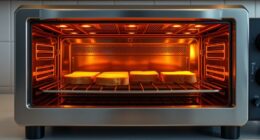Suction power alone doesn’t guarantee a robot vacuum cleans well. Your robot’s system design, airflow pathways, and brush technology play big roles in debris removal. Even with high suction, poorly optimized airflow or worn brushes will limit performance. Smaller, well-designed robots often clean better in tight spaces. Home environment and debris types also matter. To learn why other factors matter as much as power, keep exploring how these elements work together for smarter cleaning.
Key Takeaways
- Proper airflow design and system engineering often outperform raw suction power in debris removal.
- Well-optimized airflow pathways prevent blockages and maximize debris transfer, reducing reliance on high suction levels.
- Brush and roller technology, maintenance, and debris types significantly impact cleaning efficiency beyond suction strength.
- Advanced navigation and obstacle avoidance ensure thorough coverage, minimizing missed debris regardless of suction power.
- Effective debris passage, dock design, and system balance are crucial for consistent performance, not just high suction ratings.
The Limitations of Suction Power as a Cleaning Metric
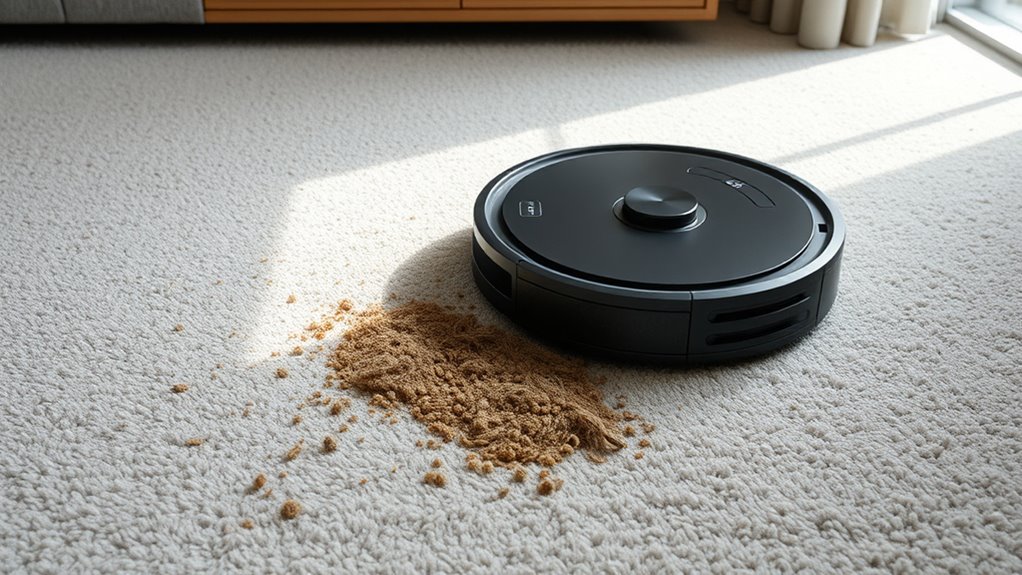
While high suction power might seem like the key to a cleaner home, it doesn’t tell the whole story. Suction power alone doesn’t guarantee better debris removal. Instead, system design plays a critical role. Airflow pathways must be optimized to maintain consistent suction and prevent loss of power. Effective roller design and debris handling are essential for capturing hair, larger debris, and preventing blockages that impair cleaning performance. Even with high suction levels, blockages or poorly integrated systems reduce overall system efficiency. Many lower-Pa robots outperform high-Pa models thanks to superior system integration that enhances debris removal. Additionally, system tuning ensures that airflow and suction work harmoniously for optimal cleaning results. Proper airflow pathways are vital for maintaining suction efficiency and preventing power loss. Furthermore, Volkswagen Tuning principles can be applied to optimize airflow and system performance in robotic vacuums, leading to more effective cleaning. Improving system efficiency through precise engineering can significantly boost cleaning effectiveness beyond raw suction power. For example, implementing airflow optimization techniques inspired by automotive tuning can further enhance the vacuum’s performance. Ultimately, cleaning performance depends more on how well the system is engineered to handle debris and airflow than on raw suction power alone.
How System Design Affects Debris Removal Efficiency
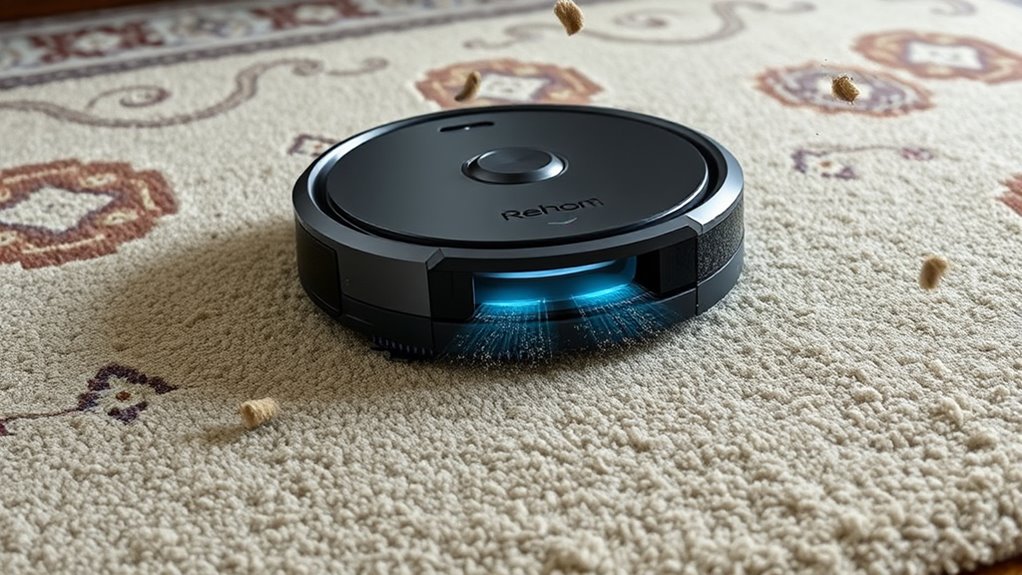
System design plays a vital role in how effectively your robot vacuum removes debris, often more so than raw suction power alone. Properly engineered airflow pathways ensure debris moves smoothly toward intake ports, reducing blockages and airflow restrictions. Consider how debris pathways and internal ducts are shaped; poorly designed ones can hinder airflow, negating high suction power. Effective system design balances suction strength with airflow optimization, preventing debris buildup and improving debris handling. Additionally, strategic placement of intake ports and roller brushes helps dislodge and funnel debris efficiently. Incorporating airflow optimization techniques and systematic engineering principles can further enhance debris removal performance, especially when integrating advanced engineering techniques. Moreover, understanding dust compartment design can significantly impact the overall efficiency by minimizing leaks and ensuring maximum debris collection.
The Role of Brush and Roller Technology in Picking Up Debris
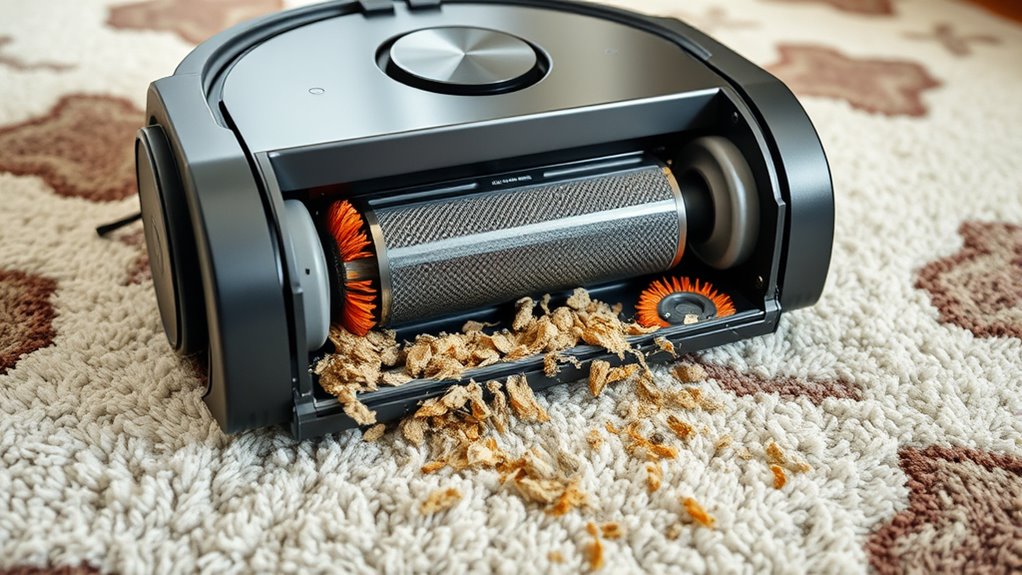
The effectiveness of your robot vacuum’s debris pickup largely depends on the design and materials of its brush and roller system. A well-designed brush and roller engage with the floor to lift debris efficiently, directing it toward the suction inlet. Silicone rollers resist hair tangles better than traditional bristle brushes, ensuring consistent performance. High-quality rollers maintain steady contact with various floor types, improving debris engagement and collection. Worn or damaged brushes and rollers reduce cleaning efficiency, regardless of suction power, because they fail to sweep debris properly. Some vacuums use dual or multi-surface brushes to handle different debris types and prevent clogging. Regular maintenance, like cleaning and replacing brushes and rollers, is essential to prevent buildup that can impair debris pickup and sustain peak performance. Using properly maintained brushes can also help extend the lifespan of your vacuum. Additionally, choosing Mazda Tuning components like high-quality rollers can enhance durability and cleaning effectiveness. Moreover, incorporating noise reduction technology in brush design can minimize operational disturbances, especially in quiet home environments. Ensuring that brushes are compatible with various floor types is crucial for maintaining optimal cleaning performance across different surfaces.
Navigation and Obstacle Avoidance Impact Overall Cleaning Performance

Effective navigation and obstacle avoidance are essential for maximizing your robot vacuum’s cleaning performance. Good navigation ensures thorough coverage, reducing missed spots and improving debris pick-up. Advanced sensors and obstacle detection help your vacuum maneuver around debris, cords, and furniture, preventing entanglement and damage. Proper obstacle avoidance also minimizes debris spread and prevents smearing dirt around delicate objects or pet waste. Additionally, intelligent navigation allows the robot to adapt to complex home layouts, avoiding getting stuck or causing collisions. Even with lower suction power, a robot with strong obstacle detection can enhance cleaning efficiency by targeting accessible debris more consistently. Incorporating spatial awareness improves a robot’s ability to navigate efficiently and adapt to changing environments, much like how navigation systems in other devices optimize performance. Developing advanced mapping techniques can further improve a robot’s efficiency by creating detailed floor plans to guide cleaning paths. Moreover, integrating machine learning algorithms enables the robot to learn from previous cleaning sessions, refining its navigation over time for better coverage and obstacle avoidance.
The Importance of Proper Debris Passage Through the Dock

Ensuring debris flows smoothly through the dock is key to maintaining your vacuum’s suction power. Poorly designed pathways can cause clogs, leading to decreased performance or even shutdowns. By focusing on clog prevention strategies and improving dock design, you can keep your robot operating efficiently. Incorporating body awareness techniques can help identify and address potential flow issues within the system. Additionally, understanding AI in Education advancements can inspire innovative design solutions for smarter debris management systems. Regular inspections and maintenance routines are also essential to prevent buildup and ensure consistent debris passage.
Clog Prevention Strategies
Proper debris passage through the dock is essential for maintaining your robot vacuum’s suction power, as blockages often occur when debris gets stuck at sharp turns or narrow pathways. To prevent clogs, consider these clog prevention strategies:
- Ensure the dock design features wider, smoother channels to improve debris flow.
- Regularly clean the suction pipe and internal pathways to remove hair, threads, and particles.
- Inspect joints and bends for obstructions that could hinder debris movement.
- Avoid sharp turns and narrow pathways in the dock, as they increase the risk of blockages and reduce suction power.
- Improving debris passage efficiency can significantly enhance overall cleaning performance and reduce maintenance needs.
Maintaining clear passageways helps prevent debris buildup, guaranteeing consistent suction and ideal cleaning performance. Proper dock design and routine maintenance are key to avoiding obstructions that impair your robot vacuum’s efficiency.
Dock Design Improvements
Upgrading your robot vacuum dock with smoother, straighter pathways and fewer turns can considerably boost debris flow and reduce blockages. An improved dock design prioritizes airflow enhancement by minimizing sharp bends in the pipe pathway, which helps prevent debris jams and clogging. Properly aligned and sealed connections guarantee consistent airflow, maintaining suction efficiency during debris transfer. Reinforced, larger diameter piping allows larger debris to pass freely, reducing manual maintenance. Regular cleaning of the dock’s interior components keeps dust and hair from building up, guaranteeing debris passes smoothly. By focusing on clogging prevention and airflow integrity, you enhance overall debris transfer, minimize internal blockages, and sustain optimal suction power — all essential for effective robot vacuum performance.
Size and Mobility: Why Slimmer Robots Can Cover More Ground
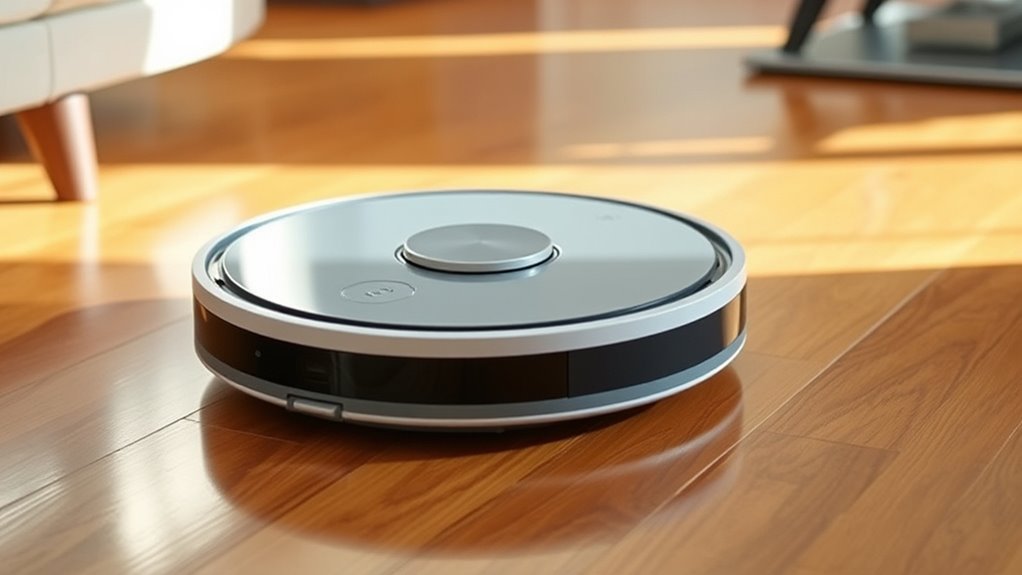
Slimmer robot vacuums, typically around 3.8 to 4.1 inches tall, can slip into tight spaces under furniture and appliances that larger models can’t reach. This increased reach boosts coverage by allowing the robot to clean areas often overlooked. Here are four reasons why size impacts mobility and efficiency:
- Enhanced navigation – slim robots maneuver easily through cluttered environments.
- Better coverage – their size allows access to more space with fewer obstacles.
- Improved maneuverability – they can navigate narrow hallways and tight corners efficiently.
- Optimized space use – their compact design helps them clean in complex environments without sacrificing performance.
The Influence of Debris Types and Home Environment on Effectiveness
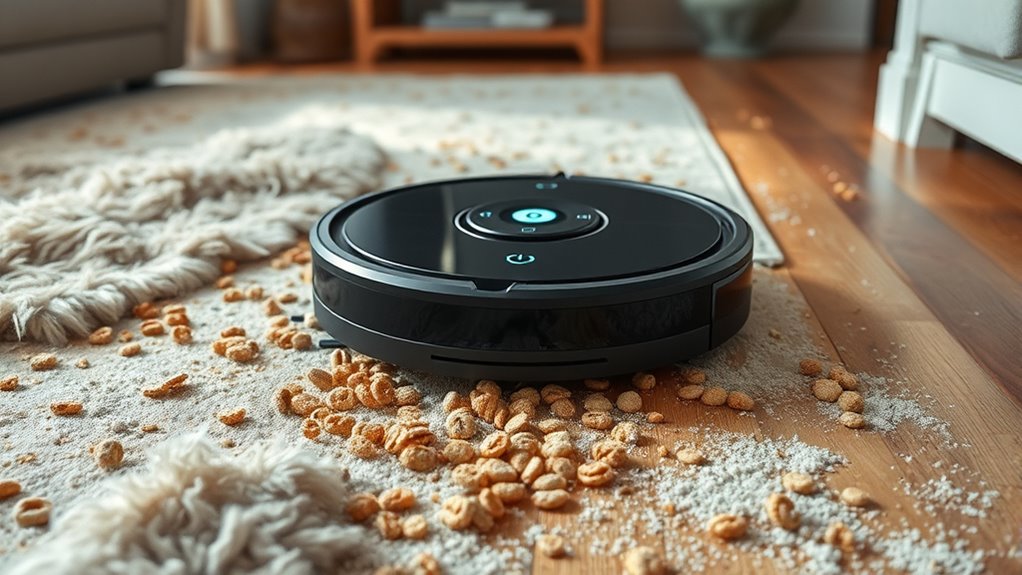
The effectiveness of your robot vacuum depends heavily on the type of debris it encounters and the environment it operates in. Different debris types, like large debris such as receipts or mulch, can clog pipes or jam rollers, regardless of suction power. Pet hair tends to wrap around rollers, damaging silicone parts and causing jams, which reduces debris pickup efficiency. Home environments with lots of pet hair or larger particles challenge the system’s performance more than fine dust. A vacuum with high suction but poor roller design or inadequate debris management can underperform in real-world conditions. The size and shape of debris influence whether suction alone can dislodge it, highlighting the importance of effective system design to handle debris types and home environments effectively.
Balancing Power, Design, and Features for Optimal Results

While high suction power is often seen as the key to better cleaning, it doesn’t guarantee ideal results on its own. To optimize robot vacuum performance, you need a balanced approach that considers system design and features. Consider these factors:
- Airflow pathways—well-engineered airflow ensures debris removal and airflow efficiency.
- Roller quality—a durable, effective brush enhances debris pickup without clogging.
- Component durability—robust parts maintain consistent suction and prevent blockages.
- Design integration—combining moderate suction with optimized airflow and system design can outperform high-Pa models in real-world cleaning.
Balancing suction power with smart design ensures better debris removal, cleaning effectiveness, and long-term performance, giving you a more efficient vacuum.
Frequently Asked Questions
What Should Be the Suction Power of Robot Vacuum Cleaner?
When selecting a robot vacuum, you wonder what suction power is ideal. You should look for a model with around 2,000 to 4,000 Pa, as that’s sufficient for most household debris. Higher suction levels don’t always signify better cleaning, especially if the system isn’t designed well. Focus on the overall system, including brushes and airflow, to guarantee effective cleaning, not just the Pa rating.
Why Isn’t My Robot Vacuum Picking Anything Up?
If your robot vacuum isn’t picking anything up, check for clogs in the filter or airflow pathways, as debris can block airflow. Make sure the dustbin isn’t full and sealed properly, and inspect for blockages in the inlet or exhaust port. Also, examine internal parts like the brushes and motor for damage or wear. External factors like water damage or broken seals can impair performance, so address these issues to restore proper suction and cleaning.
Why Is My Suction Strength Low?
When your robot vacuum’s suction is weak, it’s a sign you’re chasing shadows. You might have a clogged filter, a full dustbin, or debris wrapped around the brushes. Check for leaks, cracks, or water damage that could be harming internal parts. Over time, wear and tear also take their toll. Address these issues promptly, and you’ll boost performance. Sometimes, a little maintenance goes a long way.
What Could Cause a Drop in the Suction Power of the Vacuum Cleaner?
A drop in your vacuum’s suction power can be caused by several issues. You might have a clogged filter, an overfilled dustbin, or blocked airflow paths. Worn or damaged motors, seals, or gaskets can leak and reduce efficiency. Hair or debris wrapped around brushes or inside pipes restricts airflow. Moisture or dirt buildup inside the inlet or impeller can also physically block airflow, decreasing suction strength.
Conclusion
Remember, a robot vacuum’s true power isn’t just in its suction but in how it navigates, brushes, and adapts to your home. Like a sleek car weaving through traffic, a slim design and smart technology can outperform raw power. While high suction might seem impressive, it’s the balance with system design and features that guarantees your floors get truly clean. Focus on the whole package, not just the strength of suction alone.







